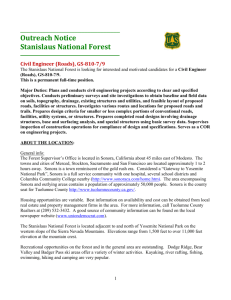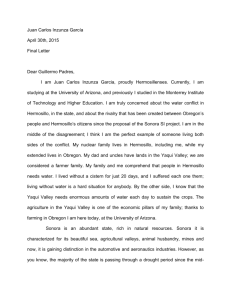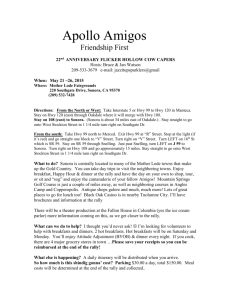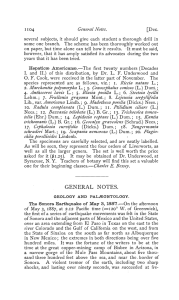Biodiversity and Conservation of the Ciénega de Saracachi area, Sonora, Mexico
advertisement
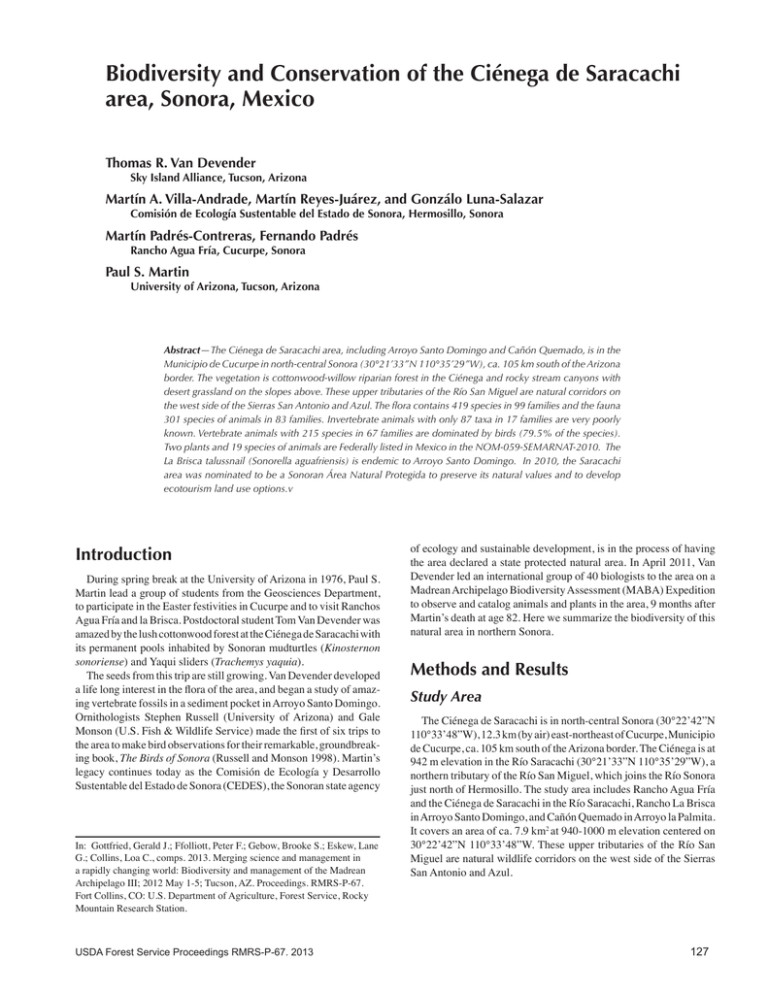
Biodiversity and Conservation of the Ciénega de Saracachi area, Sonora, Mexico Thomas R. Van Devender Sky Island Alliance, Tucson, Arizona Martín A. Villa-Andrade, Martín Reyes-Juárez, and Gonzálo Luna-Salazar Comisión de Ecología Sustentable del Estado de Sonora, Hermosillo, Sonora Martín Padrés-Contreras, Fernando Padrés Rancho Agua Fría, Cucurpe, Sonora Paul S. Martin University of Arizona, Tucson, Arizona Abstract—The Ciénega de Saracachi area, including Arroyo Santo Domingo and Cañón Quemado, is in the Municipio de Cucurpe in north-central Sonora (30°21’33”N 110°35’29”W), ca. 105 km south of the Arizona border. The vegetation is cottonwood-willow riparian forest in the Ciénega and rocky stream canyons with desert grassland on the slopes above. These upper tributaries of the Río San Miguel are natural corridors on the west side of the Sierras San Antonio and Azul. The flora contains 419 species in 99 families and the fauna 301 species of animals in 83 families. Invertebrate animals with only 87 taxa in 17 families are very poorly known. Vertebrate animals with 215 species in 67 families are dominated by birds (79.5% of the species). Two plants and 19 species of animals are Federally listed in Mexico in the NOM-059-SEMARNAT-2010. The La Brisca talussnail (Sonorella aguafriensis) is endemic to Arroyo Santo Domingo. In 2010, the Saracachi area was nominated to be a Sonoran Área Natural Protegida to preserve its natural values and to develop ecotourism land use options.v Introduction During spring break at the University of Arizona in 1976, Paul S. Martin lead a group of students from the Geosciences Department, to participate in the Easter festivities in Cucurpe and to visit Ranchos Agua Fría and la Brisca. Postdoctoral student Tom Van Devender was amazed by the lush cottonwood forest at the Ciénega de Saracachi with its permanent pools inhabited by Sonoran mudturtles (Kinosternon sonoriense) and Yaqui sliders (Trachemys yaquia). The seeds from this trip are still growing. Van Devender developed a life long interest in the flora of the area, and began a study of amazing vertebrate fossils in a sediment pocket in Arroyo Santo Domingo. Ornithologists Stephen Russell (University of Arizona) and Gale Monson (U.S. Fish & Wildlife Service) made the first of six trips to the area to make bird observations for their remarkable, groundbreaking book, The Birds of Sonora (Russell and Monson 1998). Martin’s legacy continues today as the Comisión de Ecología y Desarrollo Sustentable del Estado de Sonora (CEDES), the Sonoran state agency In: Gottfried, Gerald J.; Ffolliott, Peter F.; Gebow, Brooke S.; Eskew, Lane G.; Collins, Loa C., comps. 2013. Merging science and management in a rapidly changing world: Biodiversity and management of the Madrean Archipelago III; 2012 May 1-5; Tucson, AZ. Proceedings. RMRS-P-67. Fort Collins, CO: U.S. Department of Agriculture, Forest Service, Rocky Mountain Research Station. USDA Forest Service Proceedings RMRS-P-67. 2013 of ecology and sustainable development, is in the process of having the area declared a state protected natural area. In April 2011, Van Devender led an international group of 40 biologists to the area on a Madrean Archipelago Biodiversity Assessment (MABA) Expedition to observe and catalog animals and plants in the area, 9 months after Martin’s death at age 82. Here we summarize the biodiversity of this natural area in northern Sonora. Methods and Results Study Area The Ciénega de Saracachi is in north-central Sonora (30°22’42”N 110°33’48”W), 12.3 km (by air) east-northeast of Cucurpe, Municipio de Cucurpe, ca. 105 km south of the Arizona border. The Ciénega is at 942 m elevation in the Río Saracachi (30°21’33”N 110°35’29”W), a northern tributary of the Río San Miguel, which joins the Río Sonora just north of Hermosillo. The study area includes Rancho Agua Fría and the Ciénega de Saracachi in the Río Saracachi, Rancho La Brisca in Arroyo Santo Domingo, and Cañón Quemado in Arroyo la Palmita. It covers an area of ca. 7.9 km2 at 940-1000 m elevation centered on 30°22’42”N 110°33’48”W. These upper tributaries of the Río San Miguel are natural wildlife corridors on the west side of the Sierras San Antonio and Azul. 127 Van Devender and others Inventories Plants—The earliest plant collections in the general area were by Thomas Sheridan and Gary P. Nabhan near Cucurpe in October 1975 and March 1976. The first collections in the Ciénega de Saracachi area were by Paul S. Martin, Mary K. O’Rourke, and Van Devender in April and August 1976. Martin returned to the area in June and September 1978, June 1981 (with Raymond M. Turner), May and September 1983 (with Jodie L. Duek), and April 1984. Van Devender has collected and observed plants in the Saracachi area on 17 trips between April 1976 and April 2012, accompanied by (in chronological order) Stephen F. Hale, Charles H. Miksicek, Niall F. McCarten, Kevin B. Moodie, Richard S. White, Kenneth L. Cole, Margaret C. Kearns, Vera Markgraf, Robert S. Thompson, Mary Erickson, Piet van de Mark, Philip D. Jenkins, George M. Ferguson, A. Lilia ReinaGuerrero, Martín Villa-Andrade, Gonzálo Luna-Salazar, Martín ReyesJuárez, Mark Fishbein, Anurag Agrawal, Barbara G. Phillips, Laura Moser, John L. Anderson, Gertrudes Yanes-Arvayo, María de la Paz Montañez-Armenta, F. Isaias Ochoa-Gutiérrez, and Martín PadrésContreras. Ferguson and Hale also visited the area with Fishbein and Michelle McMahon in May 2000 and March 2001. The flora of the Saracachi area contains 419 taxa in 301 genera and 99 families. This is based on at least 393 collections in the University of Arizona Herbarium (ARIZ), and 682 observations on an October 2010 and April-May 2011 Madrean Archipelago Biodiversity Assessment (MABA) scouting trip and Expedition. Most of these records are available in the Southwest Environment Information Network (SEINet)/MABA database (Madrean.org); Some of the older collections in ARIZ are not yet in the database. Invertebrates—The few invertebrate observations from the study area were made on the MABA trips to the area. Van Devender photographed a small number of grasshoppers and dragonflies in 2010. John Palting made 100 observations of 77 species in April 2011. Robert A. Johnson observed six species of ants. Hugo Silva-Kurumiya from the Universidad de la Sierra collected a few terrestrial snails in the Ciénega de Saracachi in April 2011. Amy and Wayne Van Devender at Appalachian State University in Boone, North Carolina, identified them as Gastrocopta cristata and Hawaiia minuscula. Fishes—Alejandro Varela at the Universidad de Sonora inventoried the fish in the Ciénega de Saracahi in 1991, finding four species in three families. In April 2011, he found the same four species plus two non-native species: green sunfish/mojarra (Lepomis cyanellus) and largemouth bass/lobina (Micropterus salmoides). Herps—Van Devender has made casual observations of amphibians and reptiles on 16 trips to the study area between April 1976 and May 2011, accompanied by (in chronological order) James A. Hudnall, Robert W. Van Devender, Villa-Andrade, Luna-Salazar, Reyes-Juárez, Ferguson, Hale, Eric Wallace, and Trevor Hare. The herpetofauna of the study area presently includes six species of amphibians in three families and twelve reptiles in seven families. Birds—The primary bird surveys in the area were by Stephen M. Russell and Gale Monson who made 871 observations on six trips between April 1981 and April 1993. Villa-Andrade, Luna-Salazar, and Reyes-Juárez made casual observations as part of CEDES fieldwork. Carl Tomoff made 177 observations on the MABA Expedition in April-May 2011. Mamvmals—Only casual observations of mammals have been made on trips to the study area. 128 Biodiversity and Conservation of the Ciénega de Saracachi area, Sonora, Mexico Discussion In 2010, the book Diversidad Biológica de Sonora edited by Molina-Freaner and Van Devender (2010) summarized the present knowledge of the abundance and distribution of plants and animals in Sonora. The Ciénega de Saracachi area is an important wetland natural area in north-central Sonora. Flora Composition The flora of the Saracachi area contains 419 taxa in 301 genera and 99 families. The families with the most species are Asteraceae (61 taxa, 14.6%), Poaceae (48 taxa, 11.5%), Fabaceae (29 taxa, 6.9%), Solanaceae (14 taxa, 3.3%), Euphorbiaceae (13 taxa, 3.1%), Pteridaceae (12 taxa, 2.9%), Convolvulaceae (11 taxa, 2.6%), Lamiaceae, Malvaceae, and Scrophulariaceae (10 taxa, 2.4% each). The genera with the most species are Bouteloua (8 taxa), Brickellia and Ipomoea (7 taxa each), Euphorbia and Muhlenbergia (6 taxa each), and Cheilanthes, Solanum, and Verbena (4 taxa each). Only Arizona walnut/nogal (Juglans major) and Santa Cruz striped agave/amole (Agave parviflora) have Amenazada (Threatened) Federal protection status protected in Mexico under NOM059-SEMARNAT-2010 (Diario Oficial de la Federación, 2010), but the NOM list does not consider infraspecific taxa. Agave parviflora ssp. parviflora and the Santa Cruz beehive cactus/choyita cabezona (Coryphantha recurvata) in the study area are of special concern in Arizona. The subspecies A. p. ssp. flexiflora and A. p. ssp. densiflora are endemic to eastern Sonora (Starr and Van Devender, 2011). Lumholtz false cloak fern (Argyrochosma lumholtzii), collected by Fishbein, McMahon, and Ferguson in Arroyo Santo Domingo, is a very rare endemic species only known from a few localities in Sonora. Buddleja corrugata ssp. moranii in the same area is a variety of a Baja California butterfly bush that is a rare Sonoran endemic. Plants with northern affinities in the Saracachi flora include Arizona dewberry/zarzamora (Rubus arizonensis), goldenrod (Solidago velutina ssp. sparsiflora), stinging nettle/ortiga (Urtica dioica ssp. gracilis), rice cutgrass (Leersia oryzoides), and smallflower desert-chicory (Pyrrhopappus pauciflorus). The last two species are only known in Sonora from the Ciénega de Saracachi. Arroyo Santo Domingo has an unusual association of bigtooth maple (Acer grandidentatum, northern temperate), saguaro (Carnegiea gigantea, Sonoran Desert), and rock fig (Ficus petiolaris, tropical). A number of tropical plants that are common in tropical deciduous forest and foothills thornscrub in southern Sonora are near their northern range limits in Arroyo Santo Domingo. These include a spurge/golondrina (Euphorbia subreniformis), rock fig, ortiguilla (Gronovia scandens), and gatuño (Mimosa moniliformis). Additional tropical species that also occur in Sonoran desertscrub in central Sonora include tree ocotillo/ocotillo macho (Fouquieria macdougalii), fragrant elephant tree/torote blanco (Bursera fagaroides var. elongata), papelío (Jatropha cordata), and organpipe cactus/pitahaya (Stenocereus thurberi). Chihuahua oak/cusi peludo (Quercus chihuahuensis) is a Sierra Madre Occidental and tropical species that was collected along the Río Saracachi just north of Cucurpe, but has not been found in the study area. Twenty-four species were non-natives (5.7% of the flora, 8 grasses). Natalgrass/zacate rosado (Melinis repens), buffelgrass/zacate búfel (Pennisetum ciliare), and Johnsongrass/zacate juanón (Sorghum halepense) are invasive in some areas in Sonora, but not in the Saracachi USDA Forest Service Proceedings RMRS-P-67. 2013 VBiodiversity and Conservation of the Ciénega de Saracachi area, Sonora, Mexico area. Watercress/berro (Nasturtium officinale) is potentially invasive in the stream in Arroyo Santo Domingo. Chinaberry tree/piocha (Melia azedarach), peach/durazno (Prunus persica), and pomegranate/granada (Punica granatum) are occasional survivors near old homestead sites in Arroyo Santo Domingo. Vegetation The vegetation in the Ciénega and in the rocky, incised stream canyon in Arroyo Santo Domingo is primarily cottonwood-willow riparian forest. Dominant species include Fremont cottonwood (Populus fremontii), Goodding willow (Salix gooddingii), and Bonpland willow (S. bonplandiana). Netleaf hackberry/cúmaro (Celtis reticulata) and yewleaf willow/tarais (S. taxifolia) are locally common in the Ciénega. Huérigo (P. monticola) is near its northern distributional limit in Arroyo Santo Domingo. Arizona walnut is occasional in both areas. The floodplain of the Río Saracachi is dominated by velvet mesquite (Prosopis velutina). The slopes above the arroyos are in general desert grassland. One area in Arroyo Salsipuedes (an upper portion of Arroyo Santo Domingo) is foothills thornscrub. Fauna The insects are the largest and least studied group of animals. Additional inventories are needed in all areas in various seasons to better understand this fauna. The Mexican blue-winged grasshopper (Machaerocera mexicana (Behrstock and Sullivan 2011), the arroyo grasshopper (Heliastus benjamini), and a tropical katydid (Neobarrettia sinaloae) found in Arroyo Santo Domingo in October 2010 were new species for Sonora. Terrestrial snails are reasonably diverse, but secretive and little studied in Sonora. The endemic La Brisca talussnail (Sonorella aguafriensis) is only known from the original November 1984 collection by Russell Duncan in Arroyo Santo Domingo (Naranjo-García and Miller 1986). Snail inventories would be excellent additions to the biodiversity of the area. The fish fauna with four species is well known in the study area. The native fishes in the entire Río Sonora basin include desert chub/ charalito sonorense (Gila eremica), Gila topminnow/guatapote de Sonora (Poeciliopsis occidentalis), topminnow/charalito (Poeciliopsis sp. nov.), longfin dace/charalito aleta larga (Agosia chrysogaster), Mexican stoneroller/rodapiedras mexicano (Campostoma ornatum), and Opata sucker/matalote Ópata (Catostomus wigginsi; Alejandro Varela-Romero, pers. comm. 2009). The Opata sucker is endemic to Sonora. The Opata sucker and Gila topminnow have the Mexican Federal status Amenazada in the NOM-059-SEMARNAT-2010 (Diario Oficial de la Federación 2010). Exotic green sunfish and largemouth bass should be monitored, and control programs are needed to protect native fishes. Herpetofaunas are difficult to study for a variety of reasons. Many species only emerge from underground retreats to feed and breed during a short part of the warm season. Nocturnal, secretive species are rarely encountered. Six species of amphibians are known from the study area, but additional species are expected during the summer rainy season. At times, the lowland leopard frogs (Rana yavapaiensis) can be abundant. This frog is of special concern to state and federal agencies in the United States and Mexico because a chytrid fungus has caused population declines in many areas. The Arizona toad (Bufo microscaphus), which occurs primarily in Arizona, was found in the Ciénega in September 1990. Reptiles, with 13 species, are better known in the study area. Additional taxa, especially USDA Forest Service Proceedings RMRS-P-67. 2013 Van Devender and others snakes, will be encountered with more fieldwork. The northernmost population of the Yaqui slider (Trachemys yaquia) is in the Ciénega, and is considered threatened. Boa constrictor/corua (Boa constrictor), which was found in the Palm Canyon southeast of Magdalena (24 km northwest of the Ciénega) in September 1976, is expected to be in the study area. Six species of amphibians and reptiles (Callisaurus draconoides, Coluber flagellum, Crotalus molossus, Elgaria kingii, Rana yavapaiensis, and Thamnophis cyrtopsis) have the Mexican Federal status Amenazada or Protección Especial (Special Protection) in the NOM-059-SEMARNAT-2010 (Diario Oficial de la Federación 2010). The birds, with 171 species in 40 families, are the best-studied group of animals in the study area (Russell and Monson 1998). Additional observations in spring and late summer would add information about Neotropical migratory species. Birds of special interest observed in the study area include Osprey (Pandion haliaetus) and Gray Hawk (Asturina nitida). The Yellow-billed Cuckoo (Coccyzus americanus) has been observed elsewhere in the Municipio de Cucurpe. Nine species are Federally protected in Mexico in the NOM-059-SEMARNAT-2010 (Table 1; Diario Oficial de la Federación 2010). Mammals have been casually observed on various trips to the study area. The mammal fauna is presently at 19 species in12 families. Camera traps would provide better documentation of what medium and large species occur in the area. Smaller species, especially bats and rodents, need to be inventoried to increase the biodiversity knowledge. Arizona gray squirrel (Sciurus arizonensis) in Arroyo Santo Domingo is a southern population of this regionally endemic species. Scat of American black bear/oso negro (Ursus americanus) was observed by Trevor Hare in Arroyo Santo Domingo in April 2011. Both species are Federally protected in Mexico in the NOM- 059-SEMARNAT-2010 (Table 1; Diario Oficial de la Federación 2010). This arroyo is a potential corridor between the surrounding mountain ranges for dispersing animals, such as jaguar/tigre (Panthera onca) and ocelot (Leopardus pardalis). Fossil Record Van Devender et al. (1985) reported 51 taxa of vertebrates from the late Pleistocene Rancho La Brea Local Fauna in Arroyo Santo Domingo. The presence of Bison and Mammuthus—recent immigrants into North America from Siberia— indicated a late Pleistocene age for the deposit. The abundance of Sonoran mudturtles and leopard frogs (Rana “pipiens”, includes R. yavapaiensis) and the presence of a slider (Pseudemys scripa, now Trachemys yaquia), Red-winged Blackbird (Agelaius phoeniceus), and fishes (Agosia, Catostomus, and Poeciliopsis) indicated a paleoenvironment similar to the modern Ciénega de Saracachi before Arroyo Santo Domingo was down cut. The extinct La Brea Owl (Strix brea) was in the fauna. Additional large mammals in the fauna were a burro-sized horse (Eques cf. tau), a large horse (Eques sp.), a camel (Camelops sp.), four-horned antelope (Tetrameryx sp.), and mule deer (Odocoileus hemionus). Today white-tailed deer (O. virginianus) is common in the area. A number of species indicate warmer and/or more tropical environments than today, probably in the last interglacial period. These included Arizona mudturtle (K. arizonense), barking frog (Craugastor augusti), Kellogg’s toad (Bufo cf. kelloggii), Neotropical whipsnake (Coluber cf. mentovarius), and sabinal frog (Leptodacylus melanonotus). Conclusions The species richness in the riparian wetland habitats in the Ciénega de Saracachi, Arroyo Santo Domingo and Cañón Quemado is very 129 Van Devender and others diverse with 419 plant taxa and 215 vertebrate taxa. The invertebrate fauna has 87 taxa, but is only a sparse beginning of the true diversity. The endemic La Brisca talussnail and several other species are the only known Sonoran from the area. A total of 21 species (2 plants, 19 animals) are Federally protected in Mexico under NOM-059-SEMARNAT-2010 (Table 1; Diario Oficial de la Federación 2010). Thirteen species have the status Amenazada, three Peligro (= Endangered), and three Protección Especial. The three Peligro species are American black bear (Ursus americanus), Bell’s Vireo (Vireo bellii), and Elf Owl (Micrathene whitneyi). In 2010, CEDES submitted a proposal to the Governor of Sonora to declare The Ciénega Saracachi area a state protected natural area to conserve and restore structure and function of these important wetland habitats and to preserve the rich diversity of plants and animals. Acknowledgments We thank Ana Lilia Reina-Guerrero, Gertrudis Yanes-Arvayo, María de la Paz Montañez-Armenta, and Hugo Silva-Kurumiya for help in the field. We thank Sky Island Alliance for supporting conservation in this unique area. We thank the Palafox family of Rancho la Brisca for more than 30 years of hospitality. Sky Jacobs’ careful review improved the manuscript. This paper is dedicated to the memory of Paul S. Martin (1928-2010), mentor, friend, scientist, natural historian, and explorer. Biodiversity and Conservation of the Ciénega de Saracachi area, Sonora, Mexico References Behrstock, Robert A.; and Sullivan, Patrick H. 2011. First records of the grasshopper Machaerocera mexicana Saussure, 1859 (Orthoptera: Acrididae) from the United States and Sonora, Mexico. Insecti Mundi. 199: 1-4. Comisión de Ecología y Desarrollo Sustentable del Estado de Sonora. 2010. Etudio previo justificativo para proponer a la Ciénega de Saracachi, Municipio de Cucurpe, Sonora, como un Área Natural Protegida Estatal bajo la categoría de Reserva. Hermosillo, SON. Diario Oficial de la Federación. 2010. Norma oficial Mexicana, NOM059-SEMARNAT-2010, Protección Ambiental-Especies nativas de México de flora y fauna silvestres-Categorías de riesgo y especificaciones para su inclusión, exclusión o cambio-Lista de especies en riesgo. Emitido por la Secretaría del Medio Ambiente y Recursos Naturales. 06 de marzo del 2002. México D.F., p. 80. Molina-Freaner, Francisco; and Van Devender, Thomas R., eds. 2010. Diversidad Biológica de Sonora. Universidad Nacional Autónoma de México, Hermosillo. Naranjo-García, Edna; and Miller, Walter B. 1986. A new species of Sonorella (Gastropoda: Pulmonata: Helminthoglyptidae) from Sonora, Mexico. The Velager. 29: 166-168. Russell, Stephen M.; and Monson, Gale. 1998. The Birds of Sonora. Arizona: Tucson. 360 p. Starr, Greg; and Van Devender, Thomas R. 2011. Agave parviflora subspecies densiflora. A newly found treasure from the Sierra Madre in eastern Sonora. Cactus and Succulent Society Journal. 83: 224-231. Van Devender, Thomas R.; Rea, Amadeo M.; and Smith, Michael L. 1985. The Sangamon interglacial vertebrate fauna from Rancho la Brisca, Sonora (with A. M. Rea and M. L. Smith). Transactions of the San Diego Society of Natural History. 21: 23-55. The content of this paper reflects the views of the authors, who are responsible for the facts and accuracy of the information presented herein. 130 USDA Forest Service Proceedings RMRS-P-67. 2013


